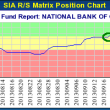“Our goal at XYZ Capital is to participate in the market on the upside and preserve capital on the downside,” said the $2,000 stuffed-suit money manager on Bloomberg TV. The cliché sounds like the company has a sophisticated strategy to earn excess returns — but don’t be misled. That’s not what the fund manager actually said.
Strategies that have lower stock market risk on the downside while achieving gains when the market goes up are nothing new. Anyone can do it. I’d bet that your portfolio is already structured this way. Let me list a few strategies that people use to participate on the upside and preserve capital on the downside:
- Invest in a balanced portfolio of stocks and bonds.When the stock market tumbles, a balanced portfolio typically goes down less. When stocks move higher, the equity portion of the portfolio participates in the gain. Full disclosure: this is what I do using index funds. It’s simple, and low-cost..
- Invest in convertible bonds rather than stocks. These unique bonds have an equity call option embedded in their structure. When a company’s stock reaches a certain price, the bond starts to move up with the stock. The bond portion puts a floor under the amount that can be lost when the stock drops. Convertible bonds require some expertise, and it’s hard to gain diversification. Funds that invest in convertibles are expensive relative to a balanced portfolio of index funds.
- Insurance against a fall in stock prices by using put options on stocks. Put options allow the buyer to sell stocks at a higher price when the market drops, thus mitigating losses. Sounds nice − but there is no free lunch. Insuring against loss with put options can be very expensive. In addition, you’ll need expertise in options trading to hedge a portfolio correctly.
- Put cash in Mason jars and bury them around the house. This isn’t a strategy I recommend, especially for those of us over the age of 50 (that’s my wife’s contribution to this article). I added it to this list just to show how silly the phrase “participate in the market on the upside and preserve capital on the downside” can be.
It’s not hard to preserve capital on the downside while participating in market gains. Literally any portfolio strategy that doesn’t put 100% in stocks will do this, providing the non-stock investments have less risk. The overall portfolio will preserve on the downside while…you know the drill. There’s nothing radical or revolutionary about asset class diversification.
I wish mutual fund companies were required to pay $1 toward the national debt every time one of their representatives said their company’s goal is to participate in the market upside while preserving capital on the downside. The deficit would be eliminated in a year.














